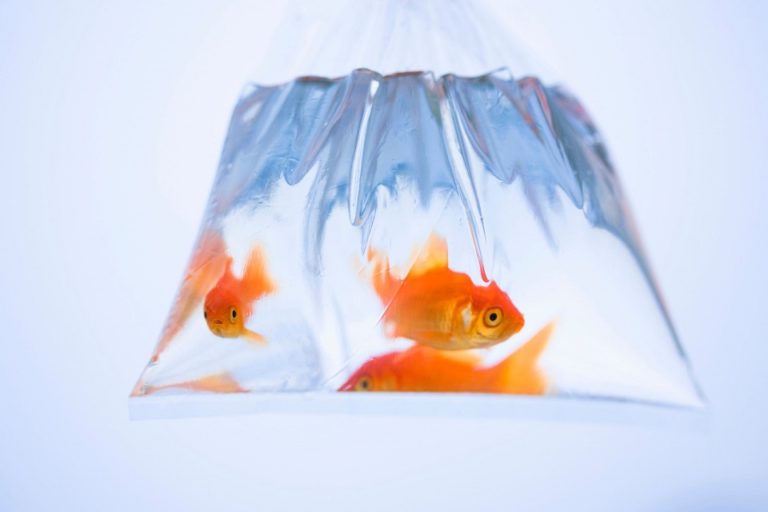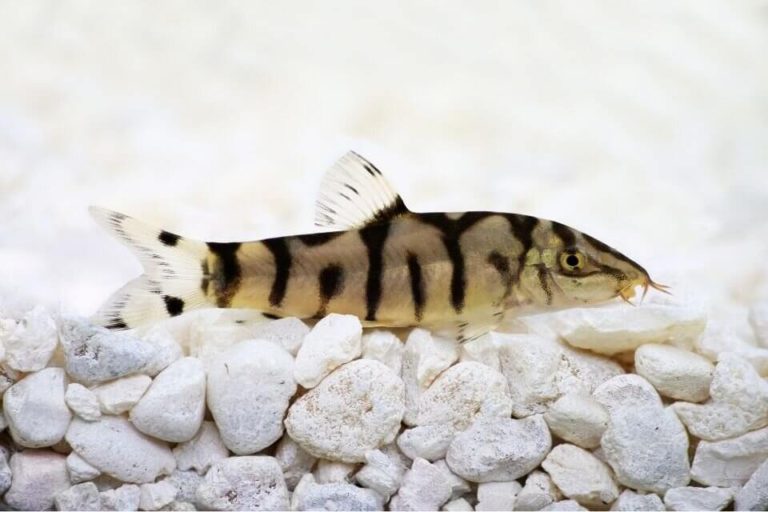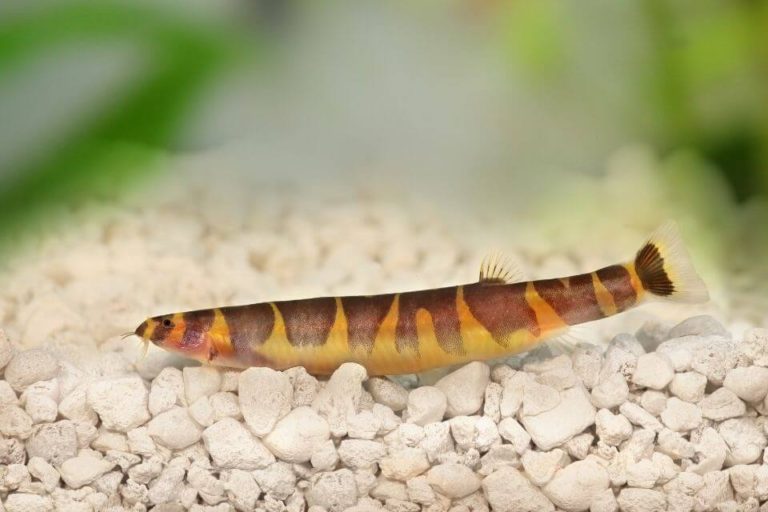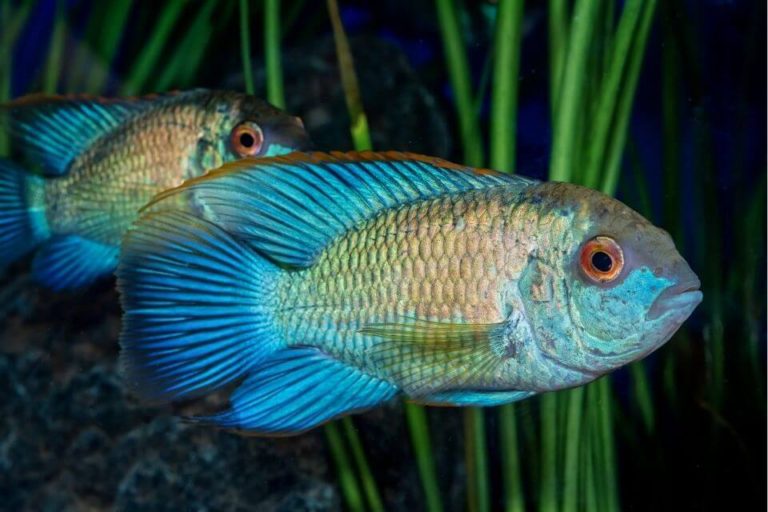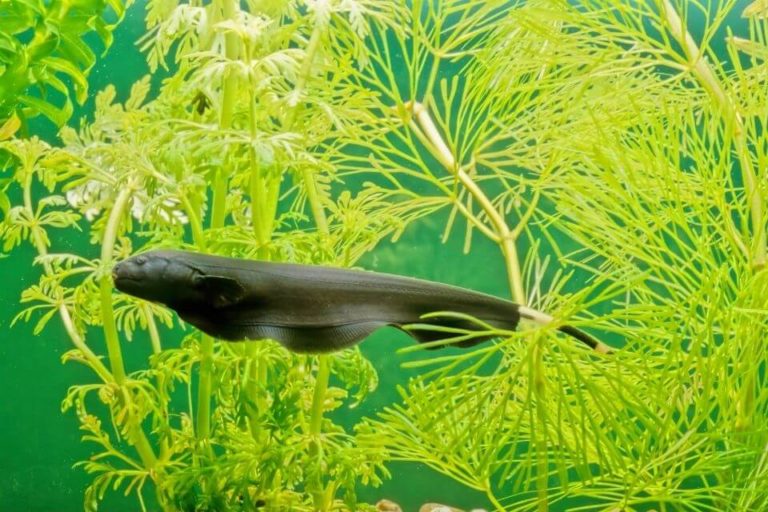Hillstream Loach Care: Lifespan, Size, Food, Tank Mates And Tank Size
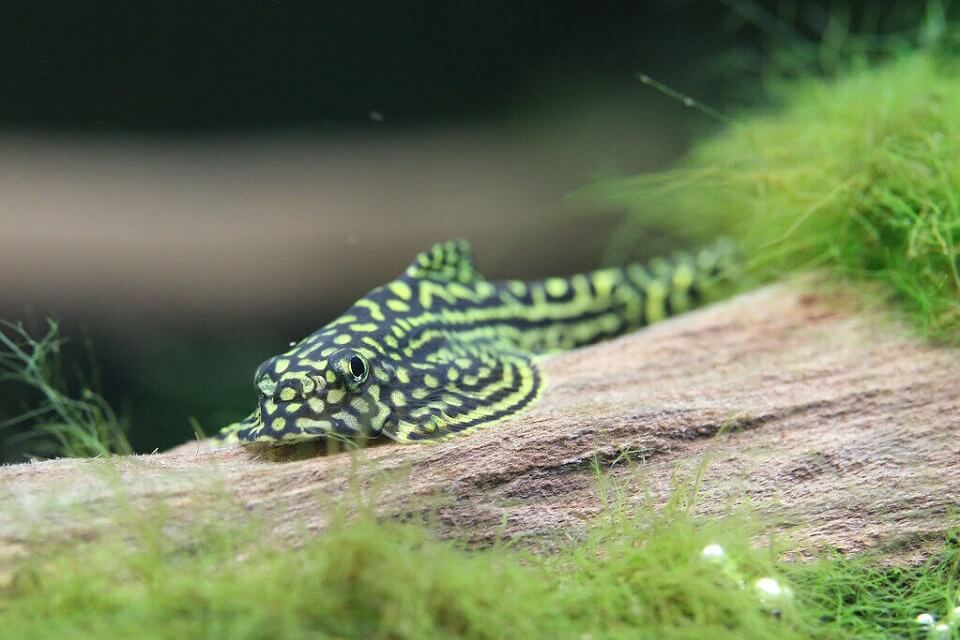
Hillstream Loach is a peaceful little Loach species that are readily available and a very popular aquarium fish you can keep in a minimum of 40 gallons tank.
They make a wonderful addition to many community tanks, and they are relatively easy to care for (at least when compared to other loach species). However, another group of Loaches deserves a bit more attention.
They are an extremely diverse family of fish that can be found in Asia. They have adapted to a very specific type of habitat: fast-flowing streams and rivers.
As such, you need to provide them with similar conditions if you want them to thrive in your aquarium. Of course, this doesn’t mean that you need a river running through your living room!
However, with careful thought and planning, it’s possible to create an ideal environment for these unique and interesting fish. Hillstream Loaches might not be for everyone, but if you’re up for the challenge, then read on!
| Quick Facts: | |
|---|---|
| Common Names | Hillstream Loach, River Loach |
| Origin | Fast-moving and warm water streams in Asia especially in China, Vietnam, Myanmar, and Thailand. |
| Family | Gastromyzontidae |
| Scientific Name | Beaufortia leveretti |
| Care Level | Easy |
| Temperament | Peaceful |
| Social | Community friendly |
| Diet | Omnivore |
| Size (average) | 2 - 3 inches |
| Lifespan | 5 - 10 years |
| Breeding | Egg layer |
| Minimum Tank Size | 40 gallons |
| Tank Setup | Freshwater, soft and smooth stones as substrate, including driftwood, rock, clay pots, and caves for hiding places. Avoid bright lights. Use a few aquarium plants. |
| Tank Temperature | 68 – 75 °F (20 – 24 °C) |
| Water Hardness | 10 - 15 dKH |
| Water pH Level | 7.0 - 8.0 |
Species Overview
The Hillstream Loach (sometimes called River Loach”) is a member of the Gastromyzontidae fish family. The binomial name for this Loach is Beaufortia leveretti.
It is best known by its genus name, Sewellia, and is sometimes referred to as the Brush-Finned Loach. It can be found in fast-flowing streams in Asia specifically in Nepal, India, Korea, China, and Vietnam.
They are primarily bottom-dwelling fish and can be found in still and moving water habitats, including streams, rivers, lakes, ponds, and flooded areas.
The Hillstream Loach’s most distinctive feature is the powerful suckermouth that allows it to attach to rocks and other solid surfaces in fast-moving water.
Hillstream Loach Size
It is one of the smallest species of Loaches you can keep in an aquarium. The average Hillstream Loach size is about 2 to 3 inches. However, most of these fish will only grow to about 2 inches in captivity.
This makes them safe for smaller tanks and community aquariums. They are not active fish species and spend most of their time hiding under rocks or in caves.
This gives them the appearance of being slightly smaller than they are, as you only ever see small parts of them sticking out!
Hillstream Loach Lifespan
They are hardy fish that will live between 5 to 10 years with proper care. You can tell your Loach is healthy and happy if it has a full appetite and spends lots of time swimming around its tank.
It’s important to note that Hillstream Loach lifespan might be shortened if its tanks aren’t properly maintained.
Behavior & Temperament
These fish are highly active, so they need ample opportunity to swim around and explore their surroundings.
Therefore, hillstream loaches are best kept in tanks that are at least 40 gallons (151 L) with plenty of rocks and driftwood to provide shelter and hiding places. There should also be moderate to strong water flow in the tank.
Though these fish are mainly found in fast-flowing streams, they’ve adapted by learning how to use their pectoral fins to cling to rocks and driftwood against the current.
As a result, they don’t mind aquarium currents that most other bottom-dwellers would find uncomfortable.
Appearance And Coloration
Hillstream Loach is small, slender fish with a unique shape. Its body is flattened from side to side, and its fins are thin, delicate, and almost translucent. The body is covered with tubercles (small bumps) that can be raised or lowered.
In addition, hillstream loaches have barbels that resemble whiskers that help them find food in fast-moving water. The hillstream loach has a very distinctive coloration.
The overall body color can be brownish-gray or grayish-tan to yellowish tan with dark gray or black markings along the sides of the body and on the dorsal fin and caudal fin (tail).
Some species have a light stripe on the sides of their bodies that is surrounded by a dark line on either side. These stripes are outlined with fine white lines and spots, giving the illusion of scales. The fins may also be marked with spots and stripes.
Hillstream loaches are some of the most active bottom-dwelling fish in the hobby. They constantly search for food and consume algae, detritus, and other organic matter.
This is good news for aquarists because it means that hill streams can help keep the substrate clean. However, it’s a bad sign if your hillstream loach has stopped roaming about in search of food.
Lethargy can be a sign of illness or poor water conditions. If your fish is not eating, you should take steps to diagnose and eliminate the problem as quickly as possible.
Reticulated Hillstream Loach Care
The Reticulated Hillstream Loach is an active fish that needs plenty of room to swim in open spaces. The ideal setup is a large tank with lots of rockwork or driftwood arranged to create caves and hiding spots where the fish can rest.
An external filter can provide high water flow to replicate the fast-moving mountain streams these fish call home. Because they are sensitive to poor water conditions and hard to keep in captivity.
This species is best for experienced aquarists who know how to create an optimal habitat. They should be kept in pairs or groups of three or more.
– Hillstream Loach Tank Size
The smallest you can go with a hillstream loach is a 40 gallons tank because you have to keep them in a group of 3 to 4 fish. And since most of them are very social creatures, you should try to keep them in a community.
A 50 gallons tank is the recommended size for these fish, and while they will do okay in a smaller aquarium, you will find that they aren’t able to swim around as much.
If you have a small tank, keep in mind that these are quick swimmers, and they will be more active than your average bottom feeder. You can increase their swimming activities by adding some caves and wood logs.
– Tank Setup
It spends most of its time on rocks, so your aquarium must be well-stocked with rocks. Please make sure that there are plenty of places for them to hide and feel secure, such as caves or crevices.
They also love heavy currents, so a good filtration system is important. If you can build a current into your setup with rock formations, you might be able to avoid a filter altogether. It’s best to keep the current at around 60 gallons per hour.
Avoid using gravel or sand as substrate, as these substrate types can cause problems for HillstreamHillstream. Instead, use smooth rocks that are not sharp.
Then, they won’t get injured if they fall over and accidentally scrape against the rocks (which can happen when they’re stressed).
When it comes to lighting for their tank, your main concern is ensuring that any lighting source doesn’t create a huge amount of heat. These fish may enjoy basking in the sun if given the opportunity.
However, too much heat will kill them quickly! They are used to higher altitudes where temperatures stay low, so don’t give them a chance to overheat by accident.
– Water Parameters And Testing
You have a lot of leeway when it comes to water parameters. They are hardy fish that can adapt to a variety of conditions. As long as you perform regular water changes, they will do just fine.
A common rule for these fish is that the colder the water gets, the more oxygen solubility increases and the less often you need water changes. This is not ideal for most aquariums, though, and I would still recommend at least weekly partial water changes.
Besides pH, hardness is another parameter to pay attention to with these fish, as they are adapted to very hard water in the wild. In most cases, a higher KH level will be better than a lower one.
But an extremely low or high KH level with some species can be problematic. The easy way to measure the water parameters is using an aquarium water testing KIT.
- Water Temperature: 68 – 75 °F (20 – 24 °C)
- Water Acidity Levels: 7.0 – 8.0 pH
- Hardness: 10 – 15 dKH
– Suitable Aquarium Plants
Your Hillstream Loach will love the cover of plants and rocks in the tank, so make sure to include plenty of both.
The best plants are fast-growing but not too delicate. You want to avoid plants that your fish can simply bite through or knock over, as Hillstream Loaches are pretty active and curious fish.
These fish also like to hide under or between the leaves and stems of plants, so thick bunches of vegetation are ideal for them.
Ideal plants for Hillstream Loach’s tank:
- Java Fern (Microsorum pteropus)
- Java Moss (Vesicularia dubyana)
- Water Wisteria (Hygrophila difformis)
- Anubias
- Amazon Sword (Echinodorus bleheri)
- Cryptocoryne species
– Common Diseases And Prevention
Although your Loach may have come to you in good health, there are still diseases you can keep an eye out for to keep it that way.
One of the most common is white spot disease (ich), which can be treated with ich medication, and which we’ll discuss later on. Other common diseases include fin rot and fungus.
Fin rot is caused by bacteria and can be treated with antibiotics. It’s easily cured if caught early, but the longer it goes untreated, the more chance there is for infection to spread throughout the body, making your fish very sick.
Fungus is a rarer occurrence in Hillstream Loaches but can occur when water quality is poor or bacterial infections are present (which invites fungal growth).
You should be able to treat this with anti-fungal medication but seek veterinary advice if you suspect this is the case as there are many different types of fungus, and some are harder to diagnose than others.
The best defense against all fish diseases is to keep your tank clean by regularly doing partial water changes, testing your water parameters, and keeping up with your tank maintenance schedule.
Hillstream Loach Diet And Feeding
Hillstream Loaches are omnivorous by nature and will eat almost anything you put in the aquarium. They love being fed a variety of food, and they eagerly accept most aquarium fish foods.
Some people feed them a diet composed solely of live or frozen brine shrimp, bloodworms, daphnia, and ground worms. Others prefer to give them sinking pellets or flakes as their staple food item.
The best feeding practice is to provide them with a varied diet that includes both meaty items and vegetable matter. A few things to remember are that they are bottom feeders and will not eat anything floating on the surface of the water.
If you want to place the food at the bottom of the tank, you should drop it along the tank wall rather than in the center. Also, it prefers to be fed more than once per day but in only small amounts each time.
When it comes to feeding these fish, less is better—it is much more important that they receive several small meals each day than one large one.
Gender Difference
Do you want to know how to tell the difference between male and female hillstream loaches? Well, you’ve come to the right place!
The most reliable way of telling a male from a female hillstream loach is by examining the ventral (belly) side of the fish. The ventral side is located directly beneath the dorsal fin (the fin on the upper part of the fish).
If you hold your HillstreamHillstream loach so that its dorsal fin is facing away from you, you’ll be able to see its belly. If it has a ventral fin on this side, it’s a male otherwise it’s female.
Hillstream Loach Breeding
Similar to other species, the Hillstream Loach is an egg scatterer and will release eggs randomly into the water column. If your loaches breed in an aquarium that is large enough, it is possible to get some fry, but the chances are slim.
A better breeding setup would be an outdoor pond or a separate aquarium set up with gravel or small pebbles at the bottom. The bigger the loose substrate, the better.
When you put a pair of Hillstream Loaches together in a breeding tank, they will start digging around in the gravel and looking for breeding spots.
Once they find a suitable place where both fish feel comfortable, they will release their eggs into the loose substrate and fertilize them by swimming back and forth over them.
The eggs will hatch after approximately 12 to 14 days, depending on the water temperature.
Hillstream Loach Tank Mates
They are unique and peaceful aquarium fish species that can make a great addition to an aquarium. It can be kept in most community aquariums. They do not like being with aggressive or territorial fish.
Some of the best Hillstream Loach tank mates include:
- Pygmy Cory Catfish
- Sterbai Cory
- Zebra Pleco
- Zebra Loach
- Cardinal Tetra
- Silver Tip Tetra
- Cherry Barb
- Galaxy Rasboras
- Harlequin Rasbora
- Emerald Dwarf Rasbora
- Zebra Danio
- Crystal Red Shrimp
- Bamboo Shrimp
Origin And Distribution
Hillstream Loaches are found in the rocky, fast-flowing streams of Asia. They come from many different countries, including Vietnam, China, Myanmar, and Thailand.
The majority of species are from China, where they inhabit the fast-moving streams that flow down the mountains into main rivers. This often means that they have to cope with temperatures that fluctuate for 24 hours.
These fish are also found in mountain lakes, where their distribution is more limited since most lakes don’t have much current.
These fish are not as popular in the hobby as other species such as tetras and cichlids, meaning that we aren’t sure how many species there are or where they all come from.
This is because they live in such remote areas, and it is difficult to get accurate records of how many species there are.
FAQS
Are Hillstream Loach Aggressive?
Hillstream Loaches are not an aggressive species. The fish are non-territorial and spend their time scavenging for food. It is a relatively peaceful species of loach but can be skittish if placed in a tank with overly boisterous tankmates.
How Many Hillstream Loaches Should Be Kept Together?
Hillstream loaches cooperate and help to keep each other in the best health possible. You should never keep a single fish by itself. Instead, keep at least two or three together to encourage continued health.
Hillstream Loaches are active during all hours of the day and will eventually establish the territory they prefer within their environment.
How Big Do Hillstream Loaches Get?
It can grow to about 2 to 3 inches (8 to 10cm) in length. However, you’re most likely to find them between 2 to 2.5 inches (5-7.5cm) in aquarium space. Hillstream loaches are one of the smallest Loaches in this fish family.
What Size Tank Do Hillstream Loaches Need?
As with all fish, hillstream loaches must have enough swimming space. That said, because these fish are bottom dwellers, you should make sure that the tank bottom is large enough for them to establish a territory.
For example, if you have four of these fish, they should probably occupy a tank no smaller than 40 gallons.
Do Hillstream Loaches Need Flow?
This omnivorous aquarium fish has a long, skinny, serpentine body that is designed primarily for life in fast-flowing streams and waters. This means they are best kept in aquariums with the right sort of flow.
Does Hillstream Loach Jump Out Of Tank?
If the Hillstream Loach is looking for a better place to lay, it might jump out of the tank. Before purchasing these fish, it’s always important to know how you can keep them inside the tank.
Make sure you have a fitted lid on your tank to protect your fish from jumping out.
How Much Does A Hillstream Loach Cost?
You can find them at around a price range of $20 to $50 at pet stores or online retailers in the US aquarium market. They are very affordable to people who like Hillstream Loaches.
Prices may be different from region to region, we did price research in the USA market.
Final Thoughts
If there is one thing that has been made abundantly clear, it is that Hillstream Loaches are the perfect fish for just about any level of fish-keeping enthusiasts.
Their easy-care nature and hardiness made them the most popular freshwater aquarium fish on the market. This makes them an excellent choice for hobbyists just starting out or even those that are looking to start a new tank.
The information in this guide will help ensure you choose the perfect Loach for you, whether you’re buying from a breeder or rescue; start properly with water quality, and learn all about their unique care needs.
They are great with other community fish, but be sure to check on compatibility before adding any Loaches to your tank. A little preparation goes a long way in ensuring it will live a long and healthy life!


